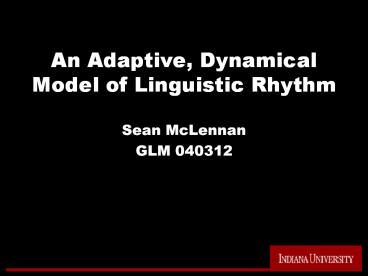An Adaptive, Dynamical Model of Linguistic Rhythm - PowerPoint PPT Presentation
Title:
An Adaptive, Dynamical Model of Linguistic Rhythm
Description:
Ramus and colleagues: examined three factors: %V ?V ?C ... hopefully a bridge between Cutler et al and Ramus et al - why should %V ?V ?C ... – PowerPoint PPT presentation
Number of Views:80
Avg rating:3.0/5.0
Title: An Adaptive, Dynamical Model of Linguistic Rhythm
1
An Adaptive, Dynamical Model of Linguistic Rhythm
- Sean McLennan
- GLM 040312
2
Underlying Intuitions
- Somewhere between the signal and low level speech
recognition, linguistic time is imposed upon real
time. - Linguistic time is more relevant to speech
recognition than real time. - Not all segments are created equal - certain
points / intervals in the speech stream are more
important for recognition than others.
3
What Rhythm Is and Is Not
- Rhythm - historically based primarily on the
perception that different languages are
temporally organized differently - Three recognized rhythmic types stress-timed
(English), syllable-timed (French), and
mora-timed (Japanese) - Rhythm implies underlying isochrony which turns
out to be absent (ex. Dauer, 1983)
4
Recent Views of Rhythm
- Ramus and colleagues
- examined three factors V ?V ?C
- V proportion of vocalic intervals in the
signal - ?V variation of length of vocalic intervals
- ?C variation of length of consonantal
intervals
5
Recent Views of Rhythm
6
Recent Views of Rhythm
7
Recent Views of Rhythm
8
Rhythm and Segmentation
- Cutler and Colleagues
- study the question of how rhythm type impacts on
the segmentation of words from the speech stream - implication being that a naïve listener (i.e. an
infant) uses rhythm as a bootstrap for early
stages of acquisition
9
Rhythm and Segmentation
- Syllable Effect
- French speakers spot ba- in balance faster than
in balcon - French speakers spot bal- in balcon faster than
in balance - rigorously reproduced, even on non-French words
- stubbornly absent in English
10
Rhythm and Segmentation
- Stress Effect
- Native English speakers find mint faster in
mintesh than in mintayve - Native English speakers find mint slower in
mintayf than in mintef and thin in thintayf
or thintef. - In missegmentations - tend to insert before a
stressed syllable (in vests) or delete before a
weak syllable (bird in)
11
Rhythm and Segmentation
- Mora Effect
- Native Japanese speakers find ta- in tanishi
faster than in tanshi - Native Japanese speakers find tan- faster in
tanshi than in tanishi. - Native Japanese speakers can find uni in
gyanuni and gyaouni but fail to find it in
gyabuni. - Native English speakers have no problem with the
Japanese task - Native French speakers show the same cross-over
effect with the Japanese task as in French and
English
12
The Proposed Model
- hopefully a bridge between Cutler et al and Ramus
et al - why should V ?V ?C impact on
segmentation? - can a naïve adaptive model responsive to V ?V
and ?C produce behavior consistent with
segmentation based on rhythm-type?
13
The Proposed Model
- V ?V and ?C need two points to be consistently
tracked vocalic onsets and offsets
14
The Proposed Model
- Use these spikes to drive two adaptive
oscillators (habituating neurons?) - Unlikely to entrain but will make predictions
15
The Proposed Model
- The accuracy of prediction will be a measure of
?C and ?V - Difference in the period will be a measure of V
16
The Proposed Model
- ?C ?V and V in turn determine the size of an
attentional window - the attentional window is a metaphor for stimulus
decay - The smaller ?C and ?V and closer V is to 50,
the more periodic the rhythm, the narrower the
window can be - The larger ?C and ?V and more divergent V is
from 50, the less periodic the rhythm, the wider
the window must be
17
The Proposed Model
- Attentional window size (hopefully) would
correlate with rhythm type and would predict
different types of segmentation / recognition
18
The Proposed Model
- Predictions, questions, and other benefits
- consistent with the correlation between rhythmic
type and consonant cluster complexity - consistent with ambisyllabicity
- perhaps attractor states predict categorical
differences - suggests manner in which to manipulate tasks to
force effects - single language-independent mechanism































